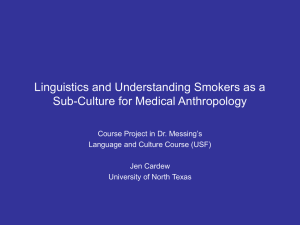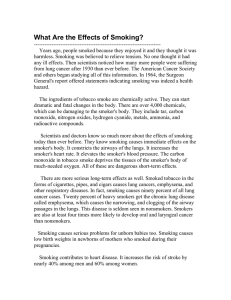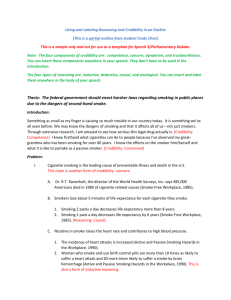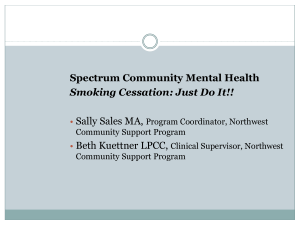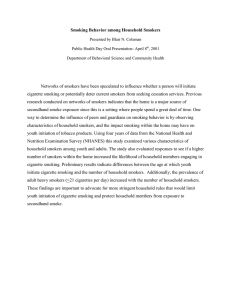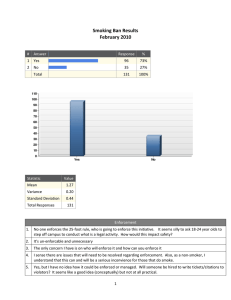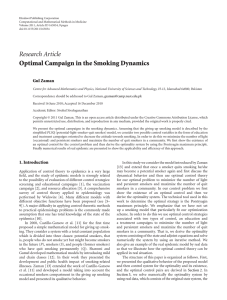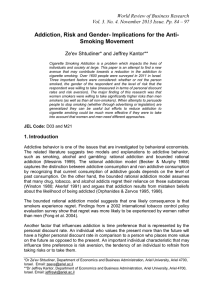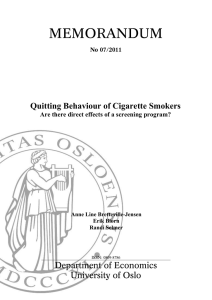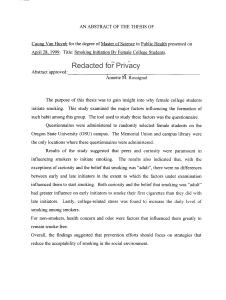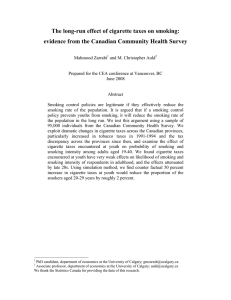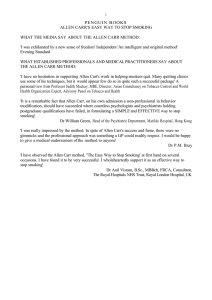Smokers and informed choice
advertisement
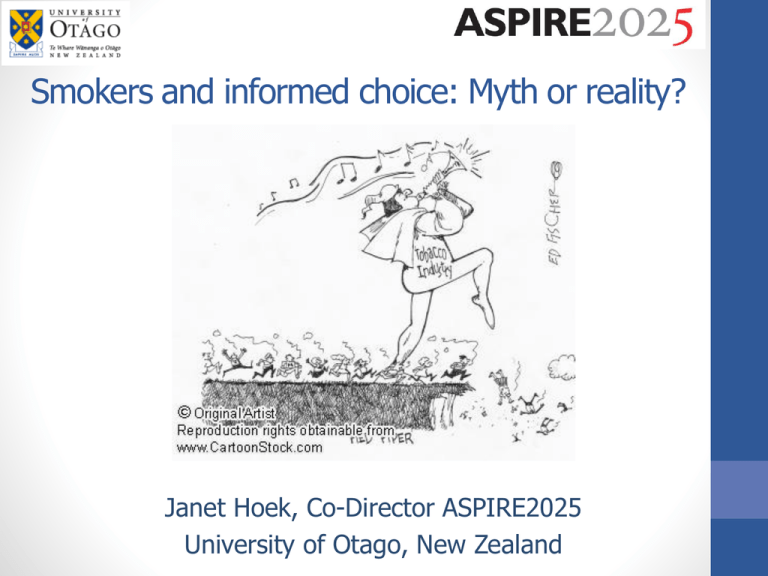
Smokers and informed choice: Myth or reality? Janet Hoek, Co-Director ASPIRE2025 University of Otago, New Zealand Overview • How has the “informed choice” argument evolved? • A quick review of industry acrobatics • How might we estimate “informed choice”? • What evidence do we have about smokers’ decisions? • What are the implications of this evidence? • A case for government leadership (aka “nanny state intervention”) Industry Position 1 Consistently questioned evidence regarding smoking’s harms ‘‘[W]e can take out ads . . .that point out the flaws of the study in question. . . . [T]here is no doubt that the careful use of these ads would be extremely embarrassing to those scientists whose methodology, data and conclusions are demonstrably wrong.’’ ‘‘[W]e can send a letter to the [scientist’s] appropriate dean or department head raising questions about the validity of a scientist’s work.’’ Industry Position 1 Directly contradicted scientific evidence and provided reassurance “We have one essential job -- which can be simply said: Stop public panic … There is only one problem – confidence, and how to establish it; public assurance, and how to create it . . . And, most important, how to free millions of Americans from the guilty fear that is going to arise deep in their biological depths – regardless of any pooh-poohing logic - every time they light a cigarette.” (Hill and Knowlton, 1953) Industry Position 1 Lied under oath In 1963, Addison Yeaman, concluded that cigarette companies were not really in the business of selling tobacco products but rather were ‘‘in the business of selling nicotine, an addictive drug…’’. (Slade et al., 1995; from a Brown & Williamson document, 17 July 1963) Industry Position 2 Master Settlement Agreements of late 1990s required industry to divulge previously secret internal files Industry Position 2 “Q. Are there substances, foods, plants, substances in our environment and that we consume which have the effect of releasing neurotransmitters? A. Yeah. … many natural substances from food or plant sources can act on these receptors… Industry Position 2 Why the change?? • Legal liability if denied risks that the courts had accepted as real Implications IF Smokers are told smoking is risky AND The industry that makes the product they use has told them so THEN They must be making an “informed choice” to smoke Estimating “informed choice” Framework proposed by Chapman & Liberman (2005) People have: • General risk awareness • Specific risk awareness • Risk understanding • Personal application So, what’s so difficult? Rationalisations, heuristics, exemptions… Cognitive biases undermine choice Exceptions disprove the rule Everyone tells you it’s bad for your health – I s’pose it is yes, but I know people that have had cancer that have never touched a smoke in their life ... or lung problems, they’ve never smoked in their life ... I know a lot of people that HAVE smoked with their children, and their children are fine, and I know- for example, my sister doesn’t smoke at all, and she had a baby that had-has a congenital deformation so... Lack of agency Higher powers are at work I know what I’m doing is not right, I know it’s not healthy but then again, it’s hereditary if someone’s got bad lungs or bad heart, it’s gonna happen. Looking on the bright side… Although half of all smokers die early they could’ve died early any way if they weren’t smoking, from other natural causes or whatever or ...... there’s just the other half of all smokers live a long happy life ... until they’re old ... Diminished influence I mean everyone around us smoked and ... yeah ... like I know it’s probably not good for us when we are that young, with everything developing but ... it’s just part of life, that’s the same as pollution in the air at the moment. Harm thresholds Because …when you are smoking you tend to think “oh-a little bit or half a cigarette or a quarter of a cigarette is not as much as a whole cigarette, so that’s less effect”. So you kind of try and tell yourself it’s not that bad when you’re smoking, especially when you’re pregnant. Harm thresholds I don’t see myself as a, to the point of a, smoker which is dangerous. Like, I probably have, maybe, a couple a day or so.” (F, S 24) Compensatory behaviours Someone could smoke a pack a day and still eat right and exercise and they’d be fine, but if you smoke a pack a day and you treat yourself like crap and eat McDonald’s every day, I mean stuff’s going to inevitably happen… some people do smoke but also treat themselves, their bodies, right. (F,28,NZE) Passing phase It kind of like goes off in my head, like a warning sign, but… I’m like too young now, so kind of carefree (laughs), I guess… I’m not going to care about this for at least twenty or thirty years. You now, I’m not at risk at the moment of whatever kind of thing.” (F,M,21) Passing phase Because when I see my future I don’t see myself as a smoker, I don’t see myself even as a social smoker. Like, when I see successful people, none of them smoke - and I want to be successful. (M, 21, SS) Implications for informed choice Can we assume smoking is an “informed choice”? • Risk understanding undermined by rationalisations, disengagement beliefs, biases and heuristics It was more so that, it just like, slowly happened. Like you’d have one, and then you’d have two or three…then so far down the road I began thinking “oh yeah, well I may as well just think of myself as a smoker. (M, 22, DS) The real context of informed choice The real context of informed choice Environment militates against informed choice Cognitive biases • Reduce risk perception • I’m different • Alter temporal perspectives • I’m too young • Affect risk assessment • I’m not hard core • Undermine risk application • I’m exercising • Impede risk understanding • I’ll quit So what does “informed choice” require? Decision-making process • Active, conscious decision making Contextual factors • Decision not impaired or coerced Knowledge factors Awareness and understanding of: • Increased health risks and addiction • Specific diseases caused by smoking • Meaning, severity, and probabilities of developing tobacco-related diseases • Consideration of long-term as well as immediate risks and benefits • Smoking’s addictiveness • Likelihood of continued smoking • Probability of quit success and relapse • Personal acceptance of all the above risks Leadership is vital • Reduce retail density • Extend smokefree bar areas • Introduce plain packaging • Increase excise tax • Run denormalisation campaigns • Enhance on-pack warnings • Disallow product flavourings Smoking and the Nanny State Sets up a false dichotomy: Free will vs government control? • Artificial dichotomy will stifle debate Government intervention reflects not a “nanny state” but a “canny state” • Intervention a pre-requisite for free, informed choice Kia ora, thank you. For more information, contact: Janet.hoek@otago.ac.nz See: www.aspire2025.org.nz



